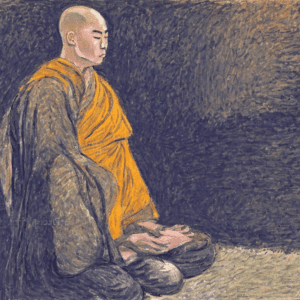Satipathana and Buddhism are inseparable. Read this post to benefit from the origin, core principles, and the wisdom sati mindfulness offers for modern living.
Table of Contents
Origins of Satipathana in Buddhism
Satipathana is Pali meaning mindfulness. For sati, the significance is right concentration. The idea in Buddhism began 2,500 years ago, taught by Shakyamuni Buddha. The Buddha’s realization that suffering arises from attachment, ignorance, and cravings laid the foundation for Satipathana. He taught that paying close attention to thoughts, emotions, and sensations, we can gain insight into the nature of suffering and ultimately find liberation from it.
How to meditate like a yogi
and enter profound samadhi
The Buddha’s Role in Popularizing Satipathana Mindfulness

The Buddha’s practice of Satipathana emphasized direct personal experience. He encouraged his followers not to take his teachings on blind faith but to investigate and verify their truth through their own experiences.
This empirical approach paved the way for mindfulness as a practice rooted in direct observation and introspection.
Early Buddhist Texts and Satipathana Practices
The early Buddhist texts, such as the Pali Canon, refer to mindfulness practices as sati. Satipathana involves awareness of the present moment and is often described as the “heart” of Buddhist meditation.
Right Satipathana in Buddhism is not just a vague notion of being present; it is an integral component of the Eightfold Path, the Buddha’s guide to living a life free from suffering. This path consists of eight interrelated aspects, with “Right Mindfulness” being one of them.
Right Mindfulness (Samma Sati) is the practice of being fully aware and attentive to the present moment without judgment. It involves observing one’s thoughts, feelings, bodily sensations, and the surrounding environment with clarity and equanimity.
Right Satipathana within the Eightfold Path
Right Mindfulness is the seventh step in the 8-fold path. Right Mindfulness is a crucial element for cultivating wisdom and insight, which are essential for attaining enlightenment.
Some Practical Examples of Right Mindfulness in Buddhism
- Right Satipathana in Daily Activities: Buddhists often bring mindfulness into routine activities, such as walking, eating, and even cleaning. By being fully present in these actions, they deepen their connection to the present moment.
- Right Satipathana Meditation: Meditation is a central practice in Buddhism, and mindfulness meditation involves observing the breath, bodily sensations, or thoughts as they arise. This practice fosters self-awareness and concentration.
- Right Satipathana of Emotions: Right Mindfulness encourages the recognition of emotions as they arise. By observing emotions without attachment or aversion, practitioners gain insight into the impermanent and conditioned nature of emotions.
Right Satipathana Meditation in Buddhism
Mindfulness meditation, often referred to as Vipassana or Insight Meditation, involves a systematic exploration of one’s inner landscape to gain insight into the true nature of reality. Attaining insight non-self is the goal of the Hinayana.
Buddhist meditation is not about escaping from the world but diving deeply into one’s inner world to gain wisdom and insight. Meditation allows practitioners to observe their thoughts and feelings with detachment, eventually leading to a profound understanding of the impermanence and interconnectedness of all things, called emptiness. This is the Mahayana approach.
Satipathana meditation is a transformative journey that takes practitioners from surface-level awareness to the depths of their consciousness. Through sustained practice, individuals gradually dismantle the layers of conditioning and habitual patterns that obscure their true nature.
The Buddha’s teachings on mindfulness meditation emphasize right Satipathana as a means to overcome suffering and attain enlightenment. He frequently instructed his disciples to focus on the breath as a foundational meditation object. By observing the breath, one can develop concentration and mindfulness. Breath also trains the mind to see the insubstantial nature and the changing essence of phenomena.
Wisdom from the Buddha: Mindfulness Quotes
Do not dwell in the past; do not dream of the future. Concentrate the mind on the present moment.
The only real failure in life is not to be true to the best one knows.
Let us live most happily, possessing nothing; let us feed on joy, like the radiant gods.
Peace comes from within. Do not seek it without.
These quotes encapsulate the essence and method of Satipathana as taught by the Buddha—a call to be present, let go of attachments and find inner peace.

Flow, the profound mental state, also called Peak Performance, can be attained with meditation and can be ‘triggered’ at will, with enough discipline. Guide to Flow Mastery will teach you how.
The Symbolism of Mindfulness in Buddhism
In Buddhism, symbols play a significant role in conveying profound spiritual truths. The symbol most closely associated with Satipathana is the “Dharma Wheel” or “Dharmachakra.” This wheel is an essential symbol in Buddhism and represents the Eightfold Path, of which Right Mindfulness is a crucial component.
The Buddhist Mindfulness Symbol sits in the Wheel of Dharma, which consists of eight spokes representing the Eightfold Path. Right Mindfulness sits at the center because it is so critical to the path of dharma.
The Dharma Wheel’s circular shape represents the continuous cycle of birth, life, death, and rebirth—samsara—in which sentient beings are trapped. Right Mindfulness, embodied by the center of the wheel, is the pivot point for individuals to break free from the cycle through awakened awareness and insight.
Symbols like the Dharma Wheel serve as visual reminders of the teachings and guide practitioners on their spiritual journey. They generate right mindfulness by calling forth the concepts and principles associated with the symbol.
Mindfulness Without Borders
One of the remarkable aspects of mindfulness is its universality. While deeply rooted in Buddhism, mindfulness transcends cultural and religious boundaries. It is a practice accessible to people of all backgrounds and beliefs.
Mindfulness is not confined to any particular religion or culture. It is a practice that can be embraced by individuals from various walks of life, regardless of their faith or lack thereof. Mindfulness invites everyone to explore their inner landscape and find peace within themselves.
In today’s globalized world, mindfulness has found its way into diverse settings. It has been adopted as a secular practice in clinical psychology, education, workplaces, and even the military. Mindfulness has proven to be a valuable tool for enhancing well-being, reducing stress, and promoting emotional resilience among people of all backgrounds.
Is Mindfulness Inherently Buddhist?
Mindfulness is inherently Buddhist. However, it is also inherently human and straddles many traditions. It is not owned by Buddhism. While mindfulness has deep roots in Buddhism and was cultivated within this tradition, it has evolved and adapted over time, making it accessible to individuals from various belief systems.
Mindfulness is not only for buddhists. As a practice, it does not require adherence to Buddhist beliefs or rituals. The mental discipline allows individuals to cultivate awareness, compassion, and inner peace. Mindfulness can be embraced by people of different faiths or no faith at all, as it is fundamentally about the human experience.
The popularity of mindfulness in contemporary society demonstrates its broad appeal. Many secular mindfulness programs, such as Mindfulness-Based Stress Reduction (MBSR) and Mindfulness-Based Cognitive Therapy (MBCT), have been developed to address modern-day stressors and psychological challenges. These right mindfulness programs have benefitted many, regardless of religious background.
the Principles of Satipathana in Buddhism
To deepen our understanding of mindfulness in Buddhism, let’s delve into its core principles, which provide a roadmap for cultivating mindfulness.
The Core Principles of Mindfulness in Buddhism
- Impermanence (Anicca): Satipathana involves recognizing the impermanent nature of all phenomena. By observing the constant change in our thoughts, emotions, and experiences, we develop equanimity and detachment.
- Suffering (Dukkha): Satipathana helps us understand the nature of suffering and its causes, which include attachment, aversion, and ignorance. Through mindful awareness, we can address the root causes of our suffering.
- No-Self (Anatta): Satipathana encourages us to examine the concept of self and identity. By observing the fluidity of our thoughts and perceptions, we gain insight into the illusory nature of a fixed, unchanging self.
The Sutra of Satipathana: Insights from Buddha’s Teachings
The Buddha’s teachings on Satipathana are encapsulated in various sutras (discourses). One of the most renowned is the Satipatthana Sutta, also known as the Sutra on the Foundations of Mindfulness. This sutra provides detailed guidance on how to practice mindfulness by directing attention to four primary areas: the body, feelings, mind, and dhammas (mental objects or phenomena).
The Satipatthana Sutta lays out a systematic framework for cultivating Satipathana, enabling practitioners to investigate their internal and external experiences with precision and clarity. By focusing on these four foundations, individuals can gain insight into the nature of reality and the impermanence of all things.
Satipathana in Tibetan Buddhism: Unique Practices and Perspectives
Tibetan Buddhism, with its rich tapestry of practices and teachings, offers its own unique approach to mindfulness. One notable practice is “Tonglen,” a meditation technique that involves sending and receiving compassion. In Tonglen, practitioners cultivate a deep awareness of suffering and compassionately breathe in the suffering of others while sending them healing and well-being.
Tibetan Buddhism also emphasizes the role of the guru or spiritual teacher in guiding practitioners on the path of mindfulness and enlightenment. The guru serves as a mentor, transmitting wisdom and guidance to students, ensuring that mindfulness is integrated into their daily lives.
Buddhist Techniques for Cultivating Satipathana
Buddhist practitioners employ a variety of techniques to cultivate Satipathana in their daily lives. These practices can range from formal meditation to mindfulness in everyday activities.
Formal Meditation Practices
- Satipathana of Breath (Anapanasati): This meditation involves focusing on the breath as it moves in and out of the body. It enhances concentration and awareness of the present moment.
- Loving-Kindness Meditation (Metta): Metta meditation cultivates loving-kindness and compassion towards oneself and others. It is a powerful antidote to negative emotions and promotes a sense of interconnectedness.
- Body Scan Meditation: This practice involves systematically scanning the body with mindful awareness, releasing tension and promoting relaxation.
Right Mindfulness and Buddhism in Everyday Life
- Satipathana in Walking (Kinhin): Practitioners engage in walking meditation, moving slowly and attentively, often in a circle. This practice enhances mindfulness in motion.
- Satipathana in Eating: Mindful eating is a practice where individuals pay full attention to the sensory experience of eating. It involves savoring each bite, recognizing the flavors, and textures, and the act of nourishing the body.
- Satipathana in Cleaning and Chores: Buddhists often incorporate mindfulness into household chores by performing them with focused attention. This transforms mundane tasks into opportunities for practice.
Mindfulness and Buddhist Psychology
Buddhist psychology, rooted in the Four Noble Truths and the Eightfold Path, explores the nature of suffering and the path to liberation. Right mindfulness plays a crucial role:
- Understanding Suffering: Satipathana allows individuals to directly observe their suffering, identifying its causes and patterns. By recognizing the root causes, they can work towards alleviating suffering.
- The Three Poisons: Buddhist psychology identifies three fundamental mental states that contribute to suffering: ignorance, attachment, and aversion. Satipathana shines a light on these poisons, enabling practitioners to dissolve them through awareness and insight.
- Emotional Regulation: Satipathana promotes emotional regulation by allowing individuals to observe their emotions without reactivity. This creates a space for understanding and responding to emotions with wisdom and compassion.
Mindfulness vs. Buddhism: Complementary or Distinct?
While Satipathana originated within Buddhism, it has taken on a life of its own in contemporary society, sometimes separate from its religious roots.
At its core, Satipathana is a practice rooted in Buddhist teachings. It was developed as a means to address the fundamental questions of existence, suffering, and liberation. In this sense, mindfulness and Buddhism are deeply interconnected.
While Satipathana is integral to Buddhism, it can also be practiced independently of any religious context. Many secular mindfulness programs and therapies have emerged, emphasizing the psychological benefits of Satipathana. These secular approaches strip away religious elements, making Satipathana accessible to a broader audience.
Mindful Eating in Buddhism
In the realm of Satipathana, eating can be a sacred act. Satipathana eating is a practice that invites us to be fully present with our food and the act of nourishing our bodies. In Buddhism, this practice takes on particular significance, as it aligns with the teachings of mindfulness and gratitude.
Satipathana Eating as a Spiritual Practice
Buddhist monastics, as well as lay practitioners, often incorporate mindful eating into their daily routine. When consuming a meal, they do so with full awareness and reverence for the sustenance it provides. Each bite is savored, not rushed, and they remain present to the sensory experience of taste, texture, and aroma.
The Role of Satipathana Bells in Mealtimes
In many Buddhist monasteries and retreat centers, the sounding of Satipathana bells signals mealtime. These bells serve as a reminder to stop, breathe, and transition into a state of mindful eating. Practitioners take a moment to express gratitude for the food and the effort that went into its preparation.
Benefits of Cultivating Satipathana in Eating Habits
- Awareness of Hunger and Fullness: Satipathana eating helps individuals become attuned to their body’s hunger and fullness cues. This awareness can prevent overeating and promote a healthier relationship with food.
- Savoring the Moment: By fully engaging with the act of eating, individuals derive greater satisfaction and enjoyment from their meals. This Satipathana practice enhances the dining experience.
- Reducing Emotional Eating: Satipathana eating encourages individuals to differentiate between physical hunger and emotional hunger. This distinction allows them to address emotional needs without turning to food as a coping mechanism.



Conclusion
In the modern world, where the pace of life often seems relentless, right Satipathana is an antidote. Satipathana invites us to slow down, to be fully present in each moment, and to develop a deeper understanding of ourselves and the world around us.
While mindfulness has evolved and adapted over the centuries, its core principles remain remarkably relevant. In a society characterized by distractions and constant busyness, the practice of mindfulness provides a refuge—a sanctuary of stillness and awareness.
The teachings of the Buddha on mindfulness continue to resonate across time and culture. They remind us of the profound potential that lies within each of us to awaken, to find peace amidst chaos, and to live with greater compassion and wisdom.
In life, remember the timeless wisdom of right Satipathana as offered by Buddhism. By embracing mindfulness, we can embark on a transformative journey—a journey that leads to a more profound understanding of ourselves and the world, a journey that offers the promise of inner peace and liberation from suffering. May we all find our own path to mindfulness, drawing inspiration from the teachings of the Buddha and the enduring legacy of this ancient practice.

May all beings be happy
May all beings be peaceful
May all beings be safe
May all beings awaken to the light of their true nature
May all beings be free







